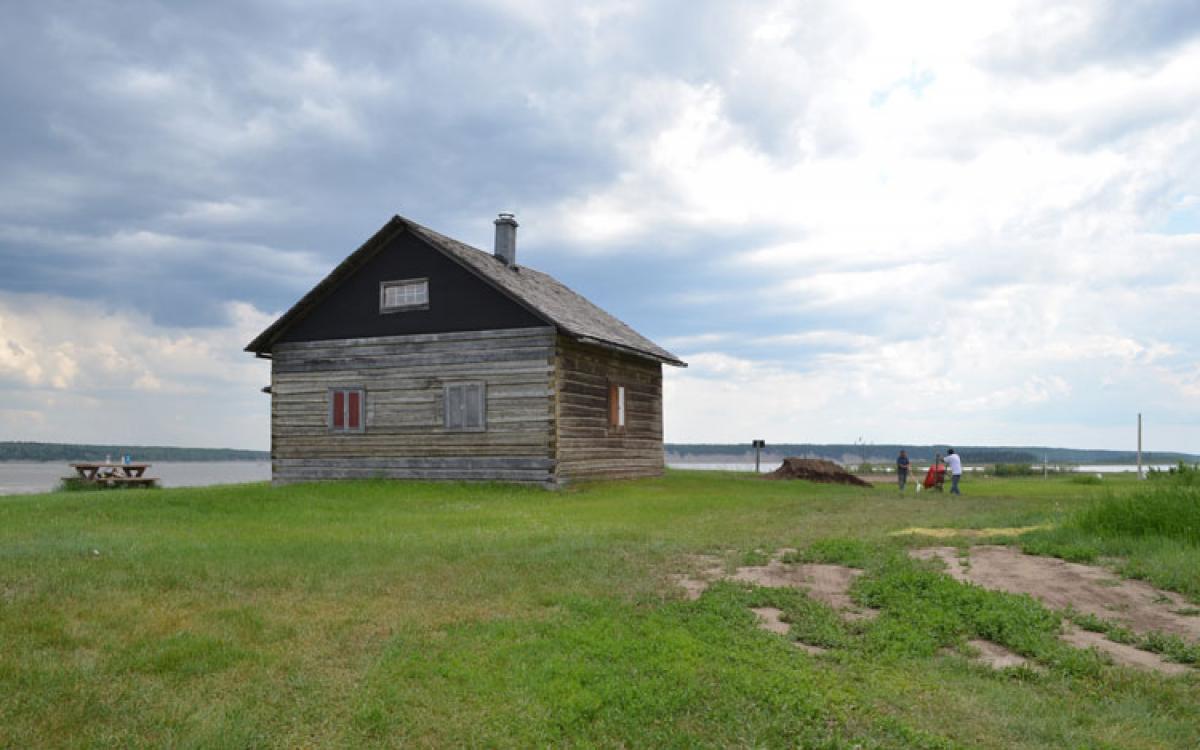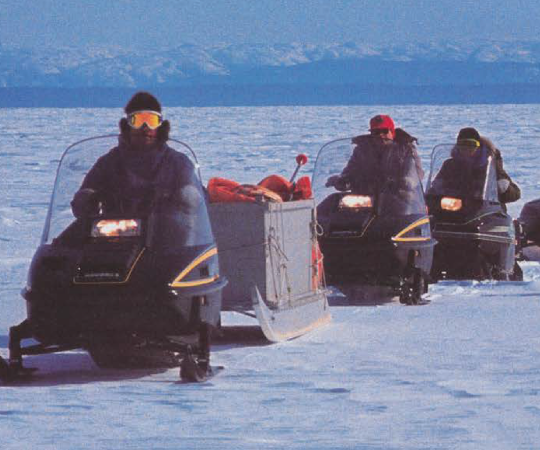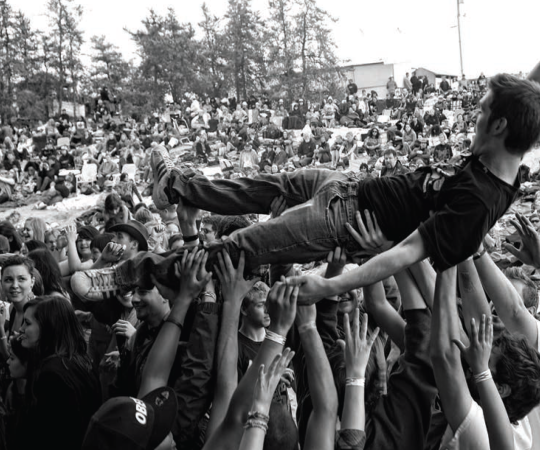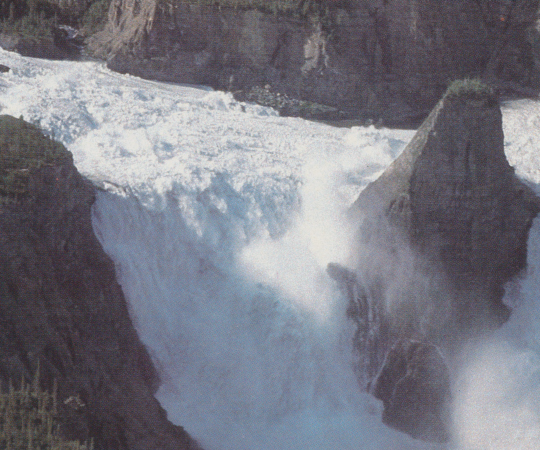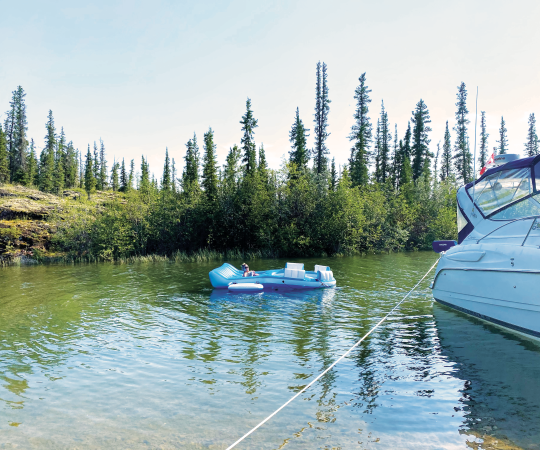Leaving Fort Simpson on my way to Yellowknife, I stopped for the night at Sambaa Deh Falls, about an hour-and-a-half drive from Simpson. The highway bridge arches over the most dramatic drop of the falls, brown water crashes below, where it’s carved out impressive cliffs over centuries. On a morning hike, I met the archetypal NWT tourist: a woman, mid-50s, with a giant camera slung around her shoulder, clothes straight out of the MEC catalogue, a brightly coloured ruck sack and the smell of sunscreen and bug dope hanging in the air around her. She’d been in Fort Simpson the day before, and came away disappointed. “There’s nothing to see there, really,” she says. “I walked around for a bit looking for some Hudson’s Bay stuff, but I couldn’t see any.”
I feel bad for Fort Simpson when I hear things like that. I fell in love with this quiet town last summer during a week-long stay preparing for a canoe trip down the Mackenzie River. It was June and the village smelled like flowers. Everywhere. The foliage was so lush it seemed like I was on a town alongside the Mississippi River rather than the Mackenzie. Standing on the hill above the island’s flats, used by the Liidlii Kue Dene as a gathering point for generations (and where the Pope visited in 1987), I could see the muddy Liard River and the blue Mackenzie, both rivers wrapping themselves around the southern tip of the island village and joining before continuing on 1,000 kilometres to the Arctic Ocean. A ribbon of brown followed the Mackenzie along the western shore for kilometres afterwards. Birds flew in and out of the eroding banks and I was hypnotized by the undulating river below.
Last winter, I was there again, filling in at the local newspaper for a week before Christmas. Things were quieter, if that’s possible. The low December sun set the town aglow for only a few hours each day, barely grazing the tops of the tall, dark and frosted pines that line the edges of the village.
There are certainly things to see here. But most of the 1,000 or so visitors the village gets every year hop on a floatplane to Virginia Falls as soon as they arrive. Fort Simpson markets itself as the jumping-off point for Nahanni National Park, a sprawling Canadian treasure full of rivers, mountains and old legends—but the town often forgets to talk about itself.

Bob Norwegian, who grew up at nearby Rabbitskin River, often hears the same criticisms I did at Sambaa Deh, and he’s trying to do something about it. “There’s folks coming in here from all over the world,” Norwegian says. “But all of a sudden it’s all fogged in or smoked in and the planes won’t take off, so there’s a whole bunch of people straggling around town here, they’re looking for something to do.”
Norwegian is running a pilot project called Rabbitskin Ventures, offering visitors tours of local sites around the village—he can show you exactly where the 1921 Treaty 11 was signed. He can also take you on a scow boat tour to Rabbitskin River, where his family’s from. “Everyone just jumps in their jet-boat and goes like a sunuvabitch down through the North Nahanni, through the mountains, and they don’t say anything about where we are. To me that’s not tourism.”
A self-professed “gabber” (I believe him) Norwegian can’t promise sights as stunning as the vistas of the Nahanni, but he’s got lots of stories. Like his ancestor’s 800-year-old trails near their Rabbitskin homestead, or how to get sugary syrup off poplar tree bark. Norwegian is a walking, talking encyclopedia of the area. He shares a tourism licence with local aviator Ted Grant of Simpson Air, who flies visitors into and over Nahanni National Park.
Tourism’s about the only boon the community has. Otherwise, Fort Simpson is dependent on government money, which, says Grant, is a false economy. “You can only carry on so long and there has to be a bottom drop out,” he says. He’s hoping a mining project to the west, Canadian Zinc, will get started up and provide some jobs for the area.
Until then, Fort Simpson might have to start telling its own story—not just the Nahanni’s. If you’re stopping by on your way elsewhere, you’ll learn that people have been doing the same things—from holding Dene gatherings at the Flats, to fur trading—for thousands of years. Fort Simpson’s story is one of a meeting place, an intersection of cultures and commerce, idly waiting to be heard.
Too windy, foggy, or smoky to get to the Nahanni for 24 hours?
Put your phone away and experience Fort Simpson:

8 a.m. Head over to the Nahanni Inn for some coffee and a greasy-spoon breakfast. Don’t be afraid to pull up a stool and stay a while—it’s a busy spot most mornings and you never know who you’ll meet.
10 a.m. Ring up Bob Norwegian (he’s well known in town so he shouldn’t be hard to find) and take one of his tours—either the half-day or the full-day (runs $650-$1200—pricey, sure, but so is gas, and his stories are priceless). You’ll get a chance to take a run up the Mackenzie on a traditional river scow and visit ancient sites.
If you’re on a budget, head down to the Visitor Information Centre in the village office. You’ll find an impressive display of artifacts from the early trading post days, as well as traditional Dene tools including a birchbark canoe. There’s even a chair, made—for the Pope’s visit—out of moose antler, hide and willow. Afterwards, check out the Open Sky Creative Society’s gallery down the road. It features work by artists around the Deh Cho, and if you’re there for its summer festival, held in late June or early July at the village flats, you can enjoy live music, dance, art demonstrations and workshops.
6 p.m. Head for dinner at Pandaville, an Asian fusion restaurant. Try the Ginger Beef pizza, if you’re feeling adventurous.
7 p.m. Walk off the pizza by checking out some of the many historical sites around town. They’re all well marked with explanatory placards. Start at the MacPherson House above the Ehdaa Flats, then walk down the lane along the riverbank and you’ll come across a Hudson’s Bay Company shed, the NWT’s oldest barn, the cabin of famous prospector Albert Faille and more.
8 p.m. Now is about the perfect time to start a round of golf. It’s still bright out and there’s bound to be lots of locals on the course—many have their own carts and drive them down to the nine-hole course from their homes. You can rent clubs or pick up some ice-cold beers in the clubhouse.
12 a.m. Wind down at the Ice Breaker Lounge, the watering hole for forest firefighters, Parks Canada employees, and fogged-in travellers. It doesn’t get busy before midnight, so don’t bother going there any earlier.

